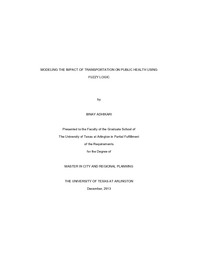| dc.description.abstract | Research has proved that built environment affect public health in various ways ranging from direct impacts like physical activity to indirect impacts such as housing affordability, employment accessibility, social capital etc. Built environment is shaped by plans and policies related to transportation. Such plans and policies make significant impacts on public health. There is increasing interest on the effects of transportation decisions in public health. Recently, transportation planners and public health practitioners have begun to find ways to work collaboratively in varieties of capacities (APHA, 2011). However, two significant aspects related to impacts of transportation on public health need to be addressed to incorporate health into transportation planning. First, impact of transportation on human health cannot be defined with certainty (Kjellstrom, Kerkhoff, Bammer, & McMichael, 2003). For example, the same level of exposure to pollution from vehicular emissions impact different age group differently. Second, physical, social, and mental well being are subjective and inherently ambiguous which cannot be easily quantified (Massad, Ortega, Barros, & Struchiner, 2009). Goodchild (1999) mentions two distinct methods to handle the uncertainty; first is the use of statistical and probability theory, and second is the use of fuzzy sets or fuzzy logic. First approach requires a fairly sophisticated knowledge of statistical theory (Goodchild, 1999, p. 5). Furthermore, statistical method does not address the ambiguity in the subjective interpretation of health status since its foundation lies in Boolean logic (Massad, Ortega, Barros, & Struchiner, 2009). This study explores the application of fuzzy logic to address the limitation of Boolean logic in dealing with the ambiguity and uncertainty in assessing health impacts of transportation. First it develops a fuzzy logic GIS system on the platform of ArcGIS. It also demonstrates the application of such a decision support system in assessing the impact of transportation on public health. The findings of this study suggest that fuzzy logic addresses the limitation of Boolean logic by adding the capacity to model uncertainty, and ambiguity related to health impacts of transportation. However, fuzzy logic performs well if detailed data are used. The Health Insurance Portability and Accountability Act of 1996 (HIPAA) prevents making individually identifiable health information public due to which most of the health data are aggregated to higher level which diminishes the performance of fuzzy logic. Additionally transportation planners use Traffic Analysis Zone as the unit of analysis which requires detailed data that might not comply with HIPAA requirements. Using health data at traffic analysis zone level can better enhance the performance of fuzzy logic and enhance current method used to assess the impact of transportation on public health. | en_US |


